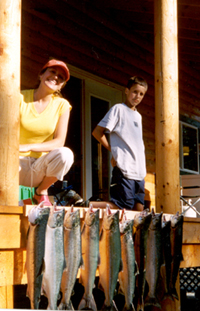|
s-u-r-v-i-v-e.com
A guide
to emergency survival preparedness
|

A "Getaway" cabin
has resources not available
in the city.
|
|
Emergency Survival Preparedness
- The Challenges of an Unexpected Catastrophy
This website will serve as a guide to surviving natural and man-made disasters, emergencies and other life threatening situations offering lists of "must have" survival gear and supplies for your bug out bag and home along with suggested courses of action.
Are you a Doomsday Prepper ? Common sense these days is making businessmen and soccer moms research emergency survival preparedness. You don't have to be a "doomsday prepper" to take reasonable precautions to protect yourself in these dangerous times. Some of the survival situations you need to prepare for are 1/ Natural Disasters such as mega earthquakes, floods, volcanic eruptions, climate change, polar axis shift, hurricanes and tornados, meteor and comet impacts, solar flares and CMEs, and ARkStorms; 2/ War, Civil Unrest, and Terrorism; 3/ Economic / Financial Meltdown; and 4/ Pandemics eminating from viruses such as Ebola. More hazards can be seen on the USGS website at http://www.usgs.gov/natural_hazards/ . While the probability of any individual event occuring and threatening your personal well-being is not great, the likelihood that at least one of these many threats to your life will occur during your lifetime is significant.
The preparation for all of these calamities depends upon where and how you are personally situated and your initial decision of whether to “Stay or Go”. By "Go", I mean traveling either on foot or otherwise to get away from the dangerous situation in which you and your family find yourself at your present location. If you’re prepared for all the types of natural disasters that are possible, then the preparations for war, civil unrest, an economic meltdown, or a pandemic will be easier. |
The Stay or Go decision -
Some of the issues you must confront in making the initial “Stay or Go” decision include a determination by you and your family of the continued availability at home of water, electricity, natural gas (or other heat producing energy sources), food, shelter (in the sence that your home is still structurally viable), medical supplies, and safety from civil unrest and bad people. Unless you are assured of adequate quantities of these items for the indefinate future, you may want to seriously consider making a "Go" decision. On the other hand, if you haven't made any preparations for going, you may be forced to stay whether you want to or not. The continued availability of electricity may well be a key determing factor in the Go / No Go decision. Electricity is frequently one of the first things to go in a disaster situation and as seen in the Hurricane Sandy aftermath, it may not be restored for weeks or even months. Many, if not most, homes in a metropolitan area will become uninhabitable without electricity in just a few days ... particulary in the winter.
Accordingly, we would highly recommend that you prepare a survival "Go" bag, or as frequently called a " Bug Out " bag, before events overtake you, with all the basic necessities to survive in an emergency. See our survival gear list for your must have items for your Bug Out bag which will cover most conceivable situations. Keep it either in your car or next to your car in the garage. With the basic Bug Out bag prepositioned, you've kept that option available. If you haven't prepared a Bug Out bag, you may be forced to stay at home and ride out whatever happens and hope that your home emergency preparations are adequate. Remember, even if you decide to stay at home, the supplies contained in your Bug Out bag may prove highly valuable in your new post disaster home environment.
What should your Bug Out bag look like you might ask. At a minimum it should be a large backpack and preferably include a pack frame. Remember, a cooler or action packer can hold the items on your survival list, but they work only if you're traveling by car and cars can run out of gas or have other problems. You should always be prepared to travel and survive on foot. Each family member should have their own backpack if they are of sufficient age to carry anything. If a 6 year old can carry a liter of water in her school backpack, that's a liter of water you don't have to tote. Many pack frames come with an integral backpack. See an outdoor equipment page after reviewing our list of "must have" survival gear and supplies. |


The Stay at Home Option - List of Basic Home Survival Supplies
1. Items in your "But Out Bag" ; PLUS
2. Generator and/or solar panels of sufficient size to power your basic household electrical needs.
3. Basic tools, axe, duct tape and a chain saw;
4. Extra gasoline with stabilizer added, propane, and cut wood
5. Coleman type gas or propane lantern and extra mantels; candels; and backup oil lamp and oil.
6. Sleeping bags
7. Coleman type 2 or 3 burner dual fuel stove or propane stove.
8. Food & Water:
-water, as much as you can reasonably store;
-food, minimum 3 months supply oriented to those foods with a longer shelf life
( rotating storage food is highly recommended ).
9. Home defense weapon (s)
10. Large size First Aid Kit, medicines, dust masks, and water purifier
11. Cell phone;
12. Crank type shortwave radio with cell phone charger.
13. Galvanized aluminum or steel garbage can to act as a Faraday Cage to protect key electronics.
14. Flashlights and various size batteries.
15. Cash. Smaller denominations.
16. Trade goods. (eg. ammo, alcoholic beverages, toilet paper, etc.)
See our suggested basic survival foods with a relatively long shelf life, some of which are:
1/ White Rice and dried beans
2/ Dried milk
3/ Pilot bread
4/ Honey
5/ Freeze dried meals and MREs from Mountain House and the like
6/ Salt & Pepper/ Sugar/ yeast/ baking powder/ baking soda
7/
Coffee or Tea in vacuum sealed cans
8/ Canned spam/ canned vegitables/ and fruit
9/ Pasta / spaghetti
10/ Olive oil
11/ Jams and other preserves
12/ Multi-Vitamins


Always carry fire making tools ! You never know when or where you may need to start a fire.
Example of Survival Preparedness "Bug Out or Go Bag" with internal frame.

For information about
emergency & survival preparedness advertising in
S-U-R-V-I-V-E.com
please Contact Us
Established
1996
Alaska Internet Marketing, Inc.
Hosting-Design-Advertising Links
Anchorage, Alaska
(907) 248 -5662
info@alaskaoutdoors.com
|
Are you prepared for unexpected emergencies?
Do you have the right gear for survival ?
Basic outdoor survival equipment
is frequently carried by hunters, and is perfect for your Bug Out bag in a disaster survival situation. |
|
General survival preparedness rule #1 - if possible buy a cabin away from urban areas where survival will be easier!
|
|
|


